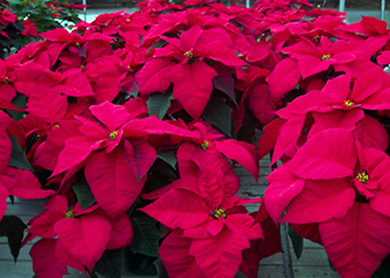Poinsettias
Poinsettias (Euphorbia pulcherrima) are subtropical plants that originated in Mexico and Guatemala. In their native climate, poinsettias are small woody shrubs that may reach a height of more than 10 feet. In most of the U.S., poinsettias are grown as indoor potted plants popular at Christmas time. While the showy bracts are suggestive of flower petals, they are really modified leaves. The actual poinsettia flowers are less conspicuous by comparison, forming a yellow to red cluster in the center of the bracts.
Marketing
This traditional Christmas plant is the best selling potted flowering plant in the U.S. Poinsettias are sold over a 6-week period beginning in early November. Greenhouse operators are efficient at growing poinsettias; while the market is relatively large, profits per plant may be small due to a large supply. Red-colored poinsettia cultivars remain the most popular, with novelty cultivars gaining some popularity in recent years. Producers should always identify market opportunities before producing novelty cultivars.
Production

Cultivar selection is a critical decision for commercial poinsettia growers, but as breeders continue to release new and exciting varieties each year it can seem an overwhelming task. In addition to the classic red and white, bracts may come in various novelty colors such as pink, peach, orange and lilac. Bract colors may also be solid, variegated, marbled or flecked. Other horticultural variations include leaf color (light to dark green colors; solid or variegated), leaf and bract shape, growth habit, height and pinching requirements to stimulate branching. Knowing your customer preferences and the market demand will be critical in selecting cultivars with the desirable traits. Another important characteristic to consider in cultivar selection is the expected time required to reach a salable stage following the start of inductive short-days. This is called the “response time” and cultivars with similar response times are organized into “response groups.” Modern cultivars range from an 8-week response time to as long as 11 weeks.

